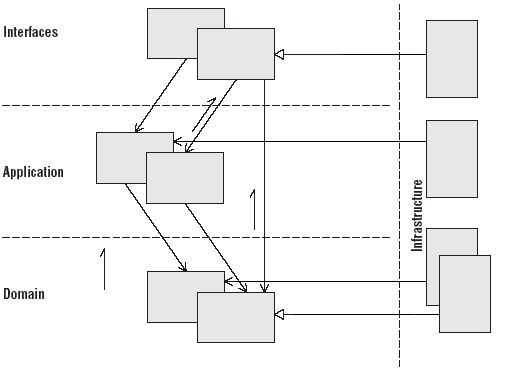Layers
Domain-Driven Design itself can be successfully applied in variety of software architectural styles. Some are very broad and tend to define every aspect of the system, others are more focused and try to address a specific demand.
The business framework itself can adapt to several architectural styles. This documentation will focus on the traditional layered architecture from the Eric Evans DDD book, improved by the usage of the Dependency Inversion Principle.
The layered architecture
The layered architecture is a classical software architecture that is commonly used in Web, enterprise and desktop applications. In this architecture, the concerns are separated into a stack of well-defined layers.
A strict layered architecture only allows to couple to the layer directly below. It can be used but we recommend a relaxed layered architecture , which allows any higher-level layer to couple to any layer below it.

Dependency inversion principle
As you can see in the diagram above, all upper layers are coupled to the infrastructure layer where technical aspects are implemented. This is not desirable in Domain-Driven Design and we can avoid it by applying the Dependency Inversion Principle.
We move the infrastructure layer to the side, where classes implement interfaces defined by other layers. Technical dependencies are injected through these interfaces:

The interface, application and domain layers are completely decoupled of any technical aspects. The architecture is made more flexible by allowing different implementations of an interface to be injected.
In SeedStack, the Dependency Inversion Principle is implemented by dependency injection.
Layers
Domain layer
The Domain Layer is where the business is expressed.
- The domain is independent of the use cases of the system, but is used to achieve their realization,
- It is a very behaviour-rich and expressive model of the domain, based on entities, values objects and aggregates.
- It contains additional blocks, such as domain services, repositories, factories, policies, etc…
Application layer
The application layer is responsible for driving the workflow of the application, executing the use cases of the system.
- These operations are independent of the interfaces by which they are exposed.
- This layer is well suited for spanning transactions, high-level logging and security.
- The application layer is thin in terms of domain logic, it merely coordinates the domain layer objects to perform the actual work through Application Services.
Interface layer
The interface layer contains the components that handle interactions with other systems, such as REST resources, Web-Services, Web application views, etc…
- It handles the interpretation, validation and translation of the inputs.
- It handles the serialization of the outputs, such as DTO classes to JSON, XML, etc.
Infrastructure layer
The infrastructure layer contains the technology-specific implementations of interfaces defined in other layers.
- It supports all of the three other layers in different ways, facilitating communication between the layers.
- It consists of everything that is external to the system itself: libraries, persistence, server, messaging and so on.
- This layer can be completely replaced by another one with other technological choices without altering the system behavior.
